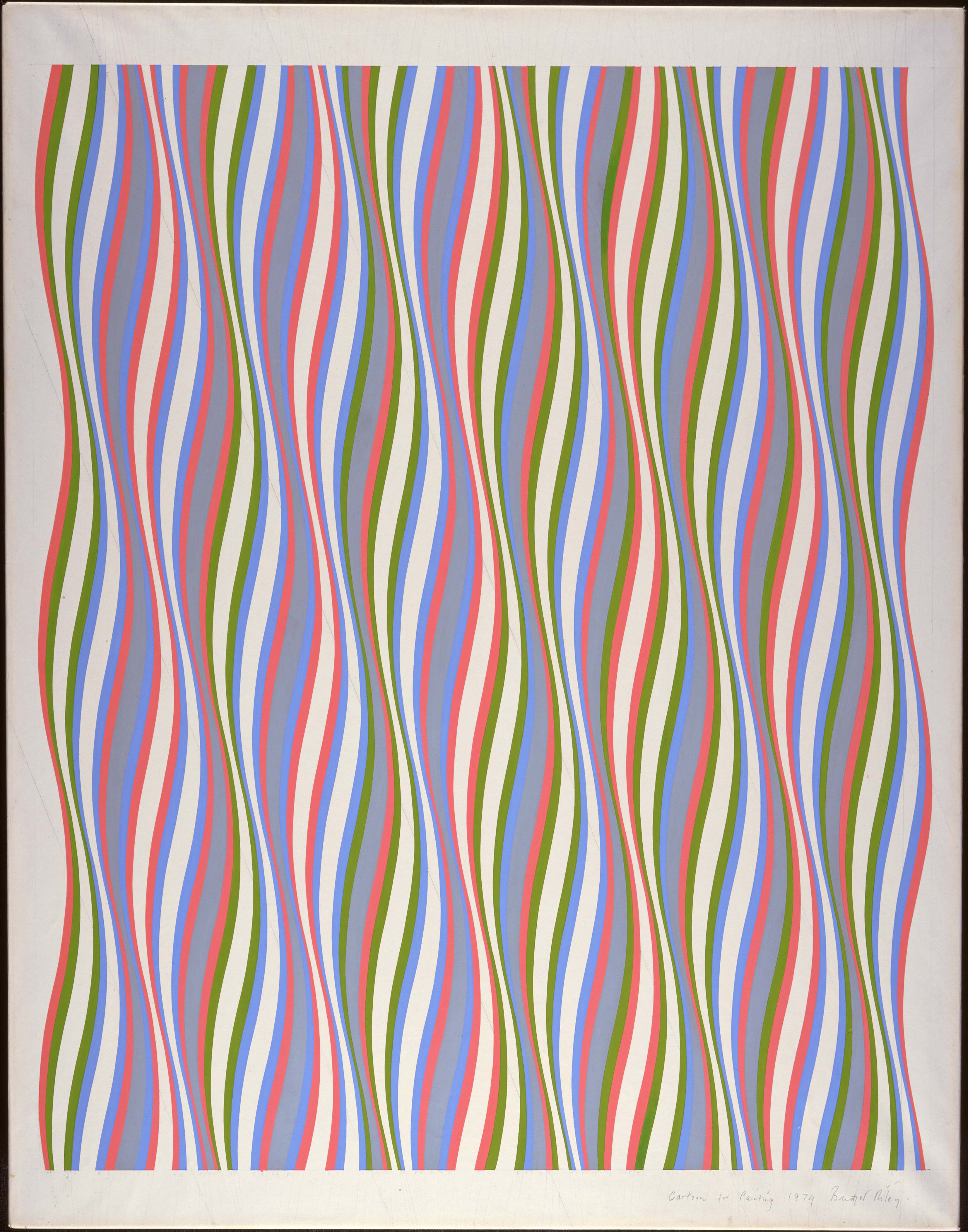
Bridget Riley CH, CBE (1926 - )
Nationality
British
Education
1949-52: Goldsmiths' College, University of London
1952-55: Royal College of Art
Taught
1959: initiated a basic design course at Loughborough School of Art
1960: Hornsey School of Art, and from 1962 at Croydon college of Arts and Crafts
1961-64: Croydon School of Art
The artist
In 1960 Riley evolved a style in which she explored the dynamic potentialities of optical phenomena. These so-called 'Op-art' pieces produce a disorienting physical effect on the eye. In her early work, geometric
forms were harnessed to mathematical progressions have the effect of buckling the appearance of surfaces and an apparent release of visual energy. In 1967, when she introduced colour, the artist simplified her forms
to release pictorial energy. Thus bands of colour were deployed to create an unfamiliar experience of light.
Riley's statements clearly reveal that she aspired to an affective poetry. She wrote of her childhood experience in Cornwall that it formed the basis of her visual life. The sea, the rocks and valleys became agents
of a greater reality that Riley was painting in order to 'make visible'.' Paradoxically, this romancing of the eye is conducted within an idiom of formal stringency and aesthetic of pure phenomenology.
The paintings came to international notice when, in 1965, Riley exhibited alongside Victor Vasarely and others at the Museum of Modern Art in New York in an exhibition called ‘The Responsive Eye’. It was around this time
that the term "Op Art" gained currency. It captured the imagination of the public and became a signal of the swinging sixties; the fashion, design and advertising industries fell in love with its graphic value, and
Riley became an art celebrity.
Riley began investigating colour in 1967, the year in which she produced her first stripe painting. Her paintings of the late 1960's and 70's became mainly concerned with the visual and emotional response to colour. In 1981,
she visited Egypt was enchanted by the colourful hieroglyphic decoration in ancient Egyptian art, "The colours are purer and more brilliant than any I had used before", she wrote. Following her visit Riley created colours
in what she called her "Egyptian palette" and produced works such as the "Ka" and "Ra" series.Riley was awarded the ACA Critics Prize in 1963 and in 1964 she was awarded a Peter Stuyvesant Foundation Travel bursary to the
USA. In 1968 she won an International Painting Prize at the Venice Biennale.She has been given honorary doctorates by Oxford (1993) and Cambridge (1995). In 1998 she became one of only 65 Companions of Honour in Britain.
In 2012, she became the first woman to receive the Sikkens Prize, the Dutch art prize recognizing the use of colour. "Painting is, I think, inevitably an archaic activity and one that depends on spiritual values" (Bridget
Riley).
Group shows include Young Contemporaries, London, 1955; Diversion, South London Art Gallery 1958; an Arts Council Touring Exhibition, 1962; Tooth's Critics Choice Exhibition, selected by Edward Lucie-Smith, 1963; John Moores'
Exhibition, Liverpool, 1963; The New Generation, Whitechapel Gallery 1964; Movement, Hanover Gallery, London, 1964; Painting and Sculpture of a Decade 1954-1964, Tate Gallery, 1964; and Op Art, touring Ireland in 1967.
Her numerous European and American exhibitions include The Sixties Collection Revisited, Aldrich Museum of Contemporary Art, Ridgefield, Connecticut, 1978.
Riley was awarded the AICA Critics Prize in 1963 and also that year a John Moores', Liverpool Open Section prize. In 1964 she was awarded a Peter Stuyvesant Foundation Travel bursary to the USA. In 1968 she won an International
Painting Prize at the Venice Biennale.
Her first solo exhibition was held at Gallery One in 1962 with a second solo show the following year. Other solo shows were held at Nottingham University, 1963; Richard Feigen Gallery, New York and Feigen Palmer Gallery, Los
Angeles, 1965; Museum of Modern Art, New York, with US tour, 1966; Venice Biennale, British Pavilion (with Phillip King), 1968; Hayward Gallery, London, 1971; National Gallery, Prague, 1971; Hayward Gallery and Kunsthalle
Nuremberg, 1992; Kettle's Yard, Cambridge, 1995; and Waddington Galleries, London, 1996.
(Tate Gallery).


